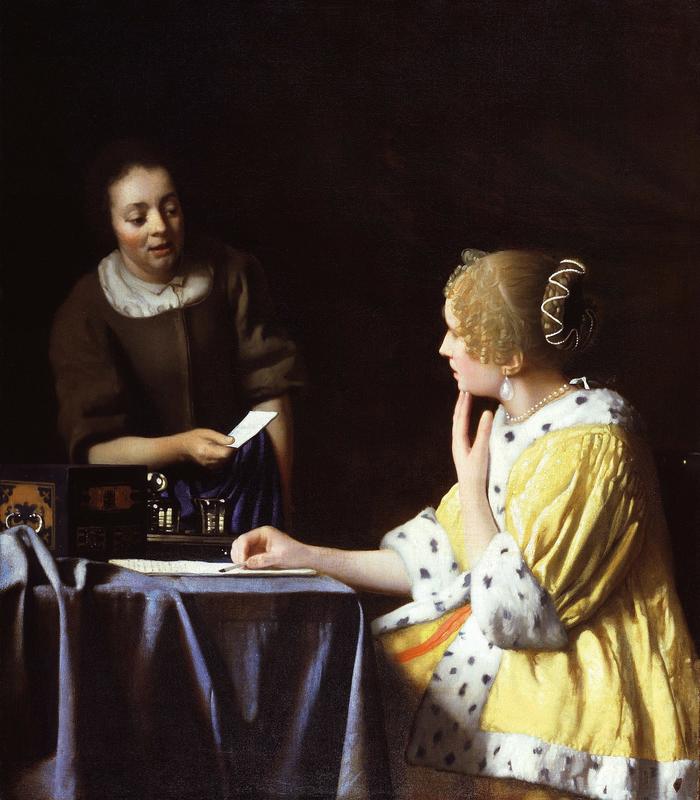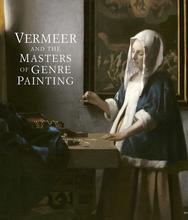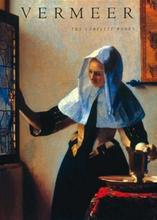More about Mistress and Maid
- All
- Info
- Shop

Contributor
Johannes Vermeer had a thing for this yellow jacket.
Do you have a favorite item of clothing that you’re rarely seen without? Vermeer did. Johannes Vermeer is famous for his intimate paintings of upper middle-class Dutch life in the 17th century. Called “genre scenes”, these paintings are all about the activities and stuff of day-to-day life, including clothing. An inventory of all the things in Vermeer’s house and studio was compiled when he died (you know, for legal reasons), and there’s a fair amount of clothing. Among items found in the great hall of the house is a “yellow satin mantle with white fur trimming”. So what the heck is a mantle, and why is it cool that he actually had a yellow one?
Clothing is depicted meticulously in Vermeer’s work as part of his record of ordinary life. He seems to have a special fondness for painting his models in the stylish separates of the day: a jacket and petticoat. The yellow jacket trimmed with white fur seen in this work appears in four other paintings by Vermeer, and if you’ve been to the National Gallery of Art, the Gemäldegalerie, or the Rijksmuseum, you’ve probably seen it before. So did four women all have the same garment? These four portraits read as a 17th century “Who Wore It Best”. While the garment in the inventory is clearly marked as one of his wife’s possessions, it’s not hard to imagine Vermeer imitating his wife’s dress on his models in order to create the most pleasing scene possible. With a description so closely matching what can be seen in his works, there’s a direct link between actual objects Vermeer and his family owned and what he chose to represent the world around him.
Why does this link matter? Genre painting is all about depicting the ins and outs of everyday life. Everyday life for the upper and upper middle classes in Holland during the seventeenth century, like it is for us today, was centered around stuff: displaying it, wearing it, buying it, and selling it. Wealth, social status, and fashionability were displayed through clothing, furniture, textiles and other household goods, and Vermeer’s house was jam-packed with all sorts of items, both lavish and humble. Many prosperous merchant families who could afford items such as a fur-trimmed mantle or a cabinet inlaid with exotic ebony made their money by trading exotic commodities across the globe. The silk used to make the jackets in the paintings and the inventory could have come from as far away as China. Examining historical documents and artworks together can provide a more complete picture of the landscape of material culture at this time. We might not know what a “yellow satin mantle with white fur trimming” would look like if not for Vermeer’s work. While we know from looking at inventories like Vermeer’s that the scenes represented in his genre paintings are somewhat more sparsely furnished than an actual house of the period, his representations of material culture bring to life objects that for the most part haven’t survived the test of time. What visual, archival and material record of our trendy purchases will remain over three centuries from now, and what sort of picture will they paint about our society? The careful attention of this and other paintings to the material world shows that our relationship to status symbols hasn’t actually changed that much.
Sources
- De Winkel, Marieke. "The Interpretation of Dress in Vermeer's Paintings." Studies in the History of Art 55 (1998): 326-39. http://www.jstor.org/stable/42622616.
- "genre painting." In The Oxford Dictionary of the Renaissance, edited by Campbell, Gordon. : Oxford University Press, 2003. http://www.oxfordreference.com.libproxy.smith.edu:2048/view/10.1093/acr….
- Janson, Jonathan. "1676 Inventory of Movable Household Goods of Vermeer's Home at Oude Langendijk, Delft." Essential Vermeer. Accessed August 24, 2018. http://www.essentialvermeer.com/inventory.html#.W39YWthKjq0.
Featured Content
Here is what Wikipedia says about Mistress and Maid
Mistress and Maid (Dutch: Dame en dienstbode) is an oil-on-canvas painting produced by Johannes Vermeer c. 1667. It portrays two women, a mistress and her maid, as they look over the mistress' letter. The painting displays Vermeer's preference for yellow and blue, female models, and domestic scenes. It is now in the Frick Collection in New York City.
Check out the full Wikipedia article about Mistress and Maid














